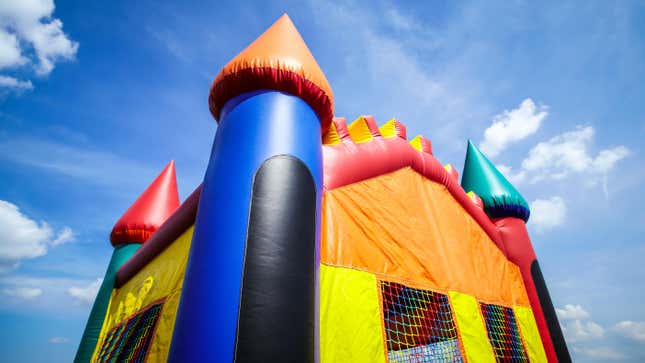
Anyone who’s ever had a sense of trepidation about jumping inside a bounce house will likely feel vindicated by recent research. A study found that there have been hundreds of injuries and at least 28 deaths worldwide over the past two decades that were caused by bounce houses set up or not properly secured during windy conditions. Both figures are likely an underestimate, the authors say, and don’t account for other bounce house-related injuries, which primarily occur among children.
The research is the culmination of a lengthy effort by a team of scientists, primarily from the University of Georgia. For years, they scoured through media reports and other sources dating back to 2000, looking for any possible accounts of weather-related bounce house incidents. They further cross-referenced what they found with available weather data.
All told, they documented 132 incidents from 2000 to 2022 that collectively left 479 people injured and 28 dead. The tally includes two incidents that occurred this year, though no major injuries or deaths were reported for either. The team’s findings were published in July in the Bulletin of the American Meteorological Society, and the researchers have also created an accompanying website for the public that provides information on each incident.
“These bounce houses aren’t something to set up and then forget to stake them into the ground,” said lead author John Knox, a geography professor at the University of Georgia’s Franklin College of Arts and Sciences, in a statement. “What could go wrong? The answer is that it could blow away in winds that are not anywhere near severe levels.”
Indeed, while many incidents did occur during or preceding clearly dangerous weather events with high winds, such as approaching thunderstorms, others took place on days with clear skies or relatively light wind speeds. About half of all incidents occurred with winds below 25 miles per hour; the American Society for Testing and Materials (ASTM) says that winds higher than 25 mph require the presence of a trained engineer to secure the house. And around a third occurred during wind speeds lower than 20 miles per hour.
The researchers dug deep into the state-by-state regulations on bounce houses in the U.S. and found that fewer than half of states had statutes concerning their use. Of these, only 19 states adhered to the guidelines recommended by the ASTM, while 17 states had no bounce house-related rules on the book or even explicitly excluded bounce houses from regulation.
The authors also note that these injuries are only the tip of the bouncy iceberg. The team’s documentation, exhaustive as it is, is likely to have missed some weather-related incidents. And other research has estimated that around 10,000 Americans are annually sent to the emergency room as a result of bounce houses, usually with broken bones or concussions. Bounce house injuries predominantly affect kids, and it’s likely no exception for those caused by wind. The authors cite one especially tragic accident that occurred last December, when high winds lifted a bounce house in Australia 30 feet into the air, ultimately leaving six children dead when it crashed back down.
Fun as these structures can be, the authors say much more must be done to make them safe.
“The regulatory landscape is all over the place from one state to another,” Knox said. “From our perspective, this isn’t good enough. Bounce houses need to be attended by someone who is weather-wise and can recognize when winds are at an unsafe level.”